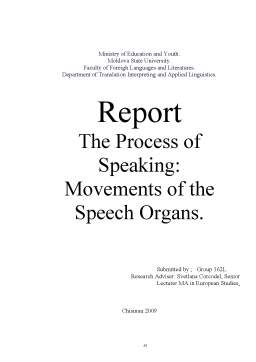Cuprins
- Introduction 3
- Speech Production 4
- The organs of speech and their function 5
- The cooperation of all organs of speech during the speech process 8
- Conclusions 10
Extras din referat
Introduction
Speech is so familiar a feature of daily life that we rarely pause to define it. It seems as natural to man as walking, and only less so than breathing. Yet it needs but a moment’s reflection to convince us that this naturalness of speech is but an illusory feeling. The process of acquiring speech is, in sober fact, an utterly different sort of thing from the process of learning to walk. In the case of the latter function, culture, in other words, the traditional body of social usage, is not seriously brought into play. The child is individually equipped, by the complex set of factors that we term biological heredity, to make all the needed muscular and nervous adjustments that result in walking. Indeed, the very conformation of these muscles and of the appropriate parts of the nervous system may be said to be primarily adapted to the movements made in walking and in similar activities. In a very real sense the normal human being is predestined to walk, not because his elders will assist him to learn the art, but because his organism is prepared from birth, or even from the moment of conception, to take on all those expenditures of nervous energy and all those muscular adaptations that result in walking.
Not so language. It is of course true that in a certain sense the individual is predestined to talk, but that is due entirely to the circumstance that he is born not merely in nature, but in the lap of a society that is certain, to lead him to its traditions. Eliminate society and there is every reason to believe that he will learn to walk, if, indeed, he survives at all. But it is just as certain that he will never learn to talk, that is, to communicate ideas according to the traditional system of a particular society. Walking is an organic, an instinctive, function (not, of course, itself an instinct); speech is a non-instinctive, acquired, “cultural” function.
Language is purely human and noninstinctive method of communicating ideas, emotions and desires by means of a system voluntarily produced symbols. These symbols are in the first place, auditory and they are produced by the so called “organs of speech.” There is no discernible instinctive basis in human speech as such, however much instinctive expressions and the natural environment may serve as a stimulus for the development of certain elements of speech, however much instinctive tendencies, motor and other, may give a predetermined range or mold to linguistic expression.
Speech Production
Besides a brain (and the knowledge of the language), what do you need to use the spoken language? We use language every day without devoting much thought to the process of speaking, but articulatory movement- the movement of the lips, tongue and other organs is among the subtlest and most adept of any actions performed by human beings. Here we are talking about the mechanisms of speech production, introduce functions for producing sound by controlling the movement of vocal organs. When the information comes from the brain to the speech organs and the last ones interrupt so as to produce a speech sound they are said to articulate the sound. The study of this aspect of the speech event is called “articulatory phonetics” and has long been a highly developed research field. It involves the analysis of the movements of the speech organs.
Articulatory phonetics describes speech articulation: how the movement of the speech organs create speech sounds. Like a car, the vocal tract is a complex machine. In real speech, the articulators are all moving around at the same time, very quickly, they are really jumping around like crazy, especially the tongue!
Though they are called “organs of speech” there are, properly speaking, no organs of speech; there are only organs that are useful in the production of speech sounds. The lungs, the larynx, the palate, the nose, the tongue, the teeth, and the lips, are all so utilized and considered as primary organs of speech. Speech is not a simple activity that is carried on by one or more organs biologically adapted to the purpose. It is an extremely complex and ever-shifting network of adjustments—in the brain, in the nervous system, and in the articulating and auditory organs—tending towards the desired end of communication. The lungs developed, roughly speaking, in connection with the necessary biological function known as breathing; the nose, as an organ of smell; the teeth, as organs useful in breaking up food before it was ready for digestion. If, then, these and other organs are being constantly utilized in speech, it is only because any organ, once existent and in so far as it is subject to voluntary control, can be utilized by man for secondary purposes. Physiologically, speech is an overlaid function, or, to be more precise, a group of overlaid functions. It gets what service it can out of organs and functions, nervous and muscular, that have come into being and are maintained for very different ends than its own.
Preview document
Conținut arhivă zip
- The Process of Speaking.doc



















